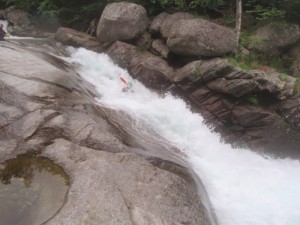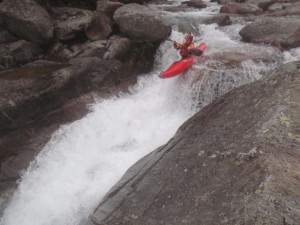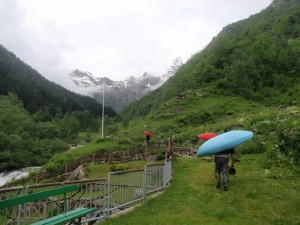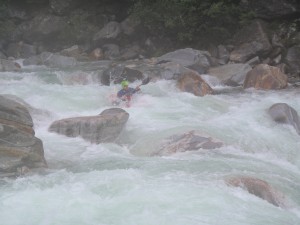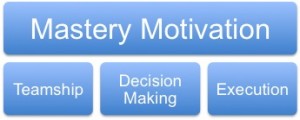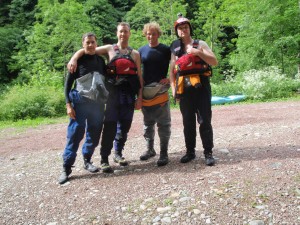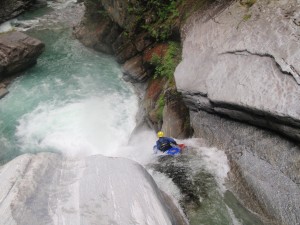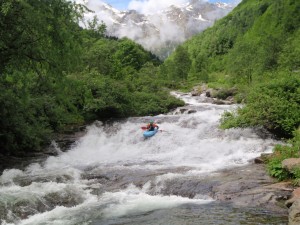8 Rivers with Dean, Andy, and (all the way from Tasmania) Harry.
We spent five days in Val Sesia, to take in the Gene 17 Festival and paddle the classics, before heading east to Ticino in southern Switzerland for some new rivers. We started with a couple of runs on the Sesia including the Gene 17 Alpin Sprint events, then the Sorba slides (waterpark fun), two runs on the Egua (classic steep creeking), the Gronda (7 hours on the water starting way up the valley) and the Sermenza (more demanding than expected with bigger volume and substantial rapids). Our three-day Ticino tour took in the Ribo (terrific waterfall but the rest of the river was low and a bit disappointing), the Rovana (high level and hard core) and the middle Versasca (high volume and challenging). It would have been good to spend more time on the Versasca, and it’s the place I’d head to first next year
As well as being epic fun, the trip was a chance to road-test the conclusions from my PhD research. In a nutshell, I’m developing a new framework for coaches and athletes to manage the psychological demands of sport performance. I’ve got projects running over the summer with slalom paddlers, athletes and rugby players. You can think of running a river as a whole series of performances, with each major rapid requiring preparation, execution and review. I’ve identified four psychological fundamentals that underpin performance:
So before running a major rapid or fall, these fundamentals need to be in place. First of all is the reason why I want to paddle the rapid in the first place. Ideally, I need to tune into Mastery Motivation, which means I’m focused on doing a rapid because I really want to test and challenge my own skills. I can get into trouble if I find my motivation pulled, even subtly, by comparing myself to others. The reason this causes problems is that Motivation feeds into Decision Making. Good Decision Making requires a clear understanding of the risks and an accurate assessment of my own ability, backed up by visualising the right lines and strokes. This can be distorted if I’m feeling at all compelled to paddle, or walk, for the wrong reason. When I’m paddling with Mastery Motivation I find it easier to wisely assess a rapid and decide whether to run it or not. Decision Making is also impacted by fatigue. Towards the end of a long day I’m more likely to fix on one part of a rapid and not give enough attention to the whole challenge. This happened to me on the ‘must-run’ drop near the end of the Rovana, when I mentally skipped over the end of the rapid because I was focused on nailing a tricky move in the middle. Fortunately I bounced off the cliff and down the final fall in one piece. I was less lucky on the Versasca, when I missed the significance of a sticky stopper right at the start of a rapid because all our attention (and safety) was focused on an undercut rock on the exit. A lost paddle ended up a small price to pay! The final important element is Teamship. On our trip there was a positive mood amongst the group, we got on well, and were confident in each other whether on the water or standing holding a throw line.
Mastery Motivation, Decision Making and Teamship all create self-confidence and the ability to Execute well. Self-confidence allows me to tolerate the fear, or at best feel the excitement, at the top of a waterfall. Self-confidence also makes its possible to transition from conscious thinking into autopilot, relying on well-grooved habits. This is Execution, and at my best I react and paddle instinctively. If the right elements aren’t in place I can get stuck in ‘paralysis through analysis’ and paddle poorly. Paddling the Ribo falls was a beautiful example of it all coming together. I was up for the challenge on my own terms, was clear about the line and technique (thanks to some waterfall coaching from Harry) and felt good about the on-bank support from the crew. If you look closely at the photo you might just make out Harry standing with a throw-line at the bottom.
After a major rapid, or at the end of a trip, it’s time to review. There were plenty of high fives after a good line down a big rapid, but after the emotional buzz it’s important to move back into a more rational Decision Making mode to learn the lessons. I don’t think I’m always as rigorous about this as I need to be. Dean and I had a proper talk after his close shave on the Sermenza, but generally on the river it was straight on to the next rapid. The review tends to come when once we’re off the river and enjoying a cold beer. But maybe that’s the best time for it, because it builds Teamship at the same time!
As always, good to hear feedback and comments. If you’ve not seen the Facebook page, its here https://www.facebook.com/DiaryOfAMiddleAgedKayaker.

